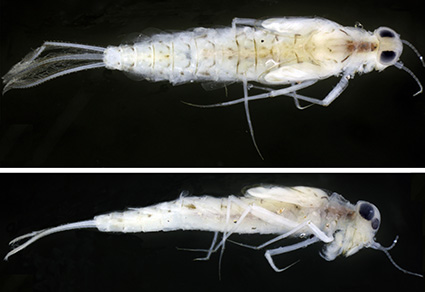Abstract
After the worst mine-tailing dam disaster which occurred in Minas Gerais state, Brazil, it was necessary to understand the extent of the biodiversity loss. Thus, based on legal obligations, a monitoring of the fauna and flora along the Rio Doce basin was developed. From this large study, surprisingly, two undescribed psammophilous mayfly species were collected. Given the environmental disaster, and the particular concern with species that inhabiting sandy bottom, the two new species may be already threatened. Considering the reported circumstances, our objective is to described the new species and carry out their extinction risk assessment following the IUCN protocol. Apobaetis irai sp. nov. can be distinguished by the size and shape of the setae in the distal middle area of the dorsal surface of the labrum, with 3 minutes, blunt spatulate setae and the shape of the labial palp; is likely to be threated, plausibly eligible, at least, as Vulnerable (VU) B2ab(iii)+D2. Rivudiva watu sp. nov., can be distinguished by the distal shape of glossae, absence of row of setae on ventral margin on the hind tibiae and hypopharynx without distomedial projection; given its distribution, it was not directly impacted by the disaster, however, there is not enough data to accurately estimate the extent of its occurrence (EOO) and area of occupancy (AOO), therefore, it may be eligible for Data Deficient (DD).
References
Biodiversitas, F. (2021) Livro vermelho da biota aquática do Rio Doce ameaçada de extinção após o rompimento da barragem de Fundão: Mariana, Minas Gerais: crustáceos, efêmeras, odonatos e peixes. 1. edição. Fundação Biodiversitas, Belo Horizonte, MG, 271 pp. Available from: https://biodiversitas.org.br/wp-content/uploads/2021/08/Livro_Vermelho_Biodiversitas_Renova_Rio-Doce.pdf (accessed 3 October 2022)
CEPTA [Centro Nacional de Pesquisa e Conservação da Biodiversidade Aquática Continental] (2015) Nota técnica Nº. 24, de 24 de novembro de 2015. Consequências parciais na biodiversidade aquática da bacia do rio doce, provocadas pelo rompimento da barragem de rejeitos de mineração da Samarco Mineradora S.A. no município de Mariana, MG. Available from: https://www.icmbio.gov.br/portal/publicacoes?id=7862:documentos-rio-doce (accessed 18 April 2022)
Coelho, A.L.N. (2009) Bacia hidrográfica do Rio Doce (MG/ES): Uma análise socioambiental integrada. Revista Geografares, 7 (7), 131–146. https://doi.org/10.7147/geo7.156
Coleman, C.O. (2006) Substituting time-consuming pencil drawings in arthropod taxonomy using stacks of digital photographs. Zootaxa, 1360 (1), 61–68. https://doi.org/10.11646/zootaxa.1360.1.4
Cruz, P.V. & De-Souza, M.R. (2014) Two new species of Apobaetis Day, 1955 (Ephemeroptera: Baetidae) from Brazil. Zootaxa, 3866 (4), 591–599. https://doi.org/10.11646/zootaxa.3866.4.9
Cruz, P.V., Boldrini, R. & Hamada, N. (2020) Redescription of Apobaetis lakota McCafferty, 2000 (Ephemeroptera: Baetidae) and description of two new species from Brazil. Zootaxa, 4885 (2), 249–258. https://doi.org/10.11646/zootaxa.4885.2.6
Cruz, P.V., Boldrini, R., De Lima, C.R. & Hamada, N. (2022) It is a mess! How many species are in Rivudiva trichobasis Lugo-Ortiz & McCafferty, 1998 (Ephemeroptera: Baetidae)? European Journal of Taxonomy, 789 (1), 153–191. https://doi.org/10.5852/ejt.2022.789.1639
Fundação Renova (2016) Relato de Atividades. Available from: https://www.fundacaorenova.org/wp-content/themes/fundacao-2016/arquivos/relatorioatividades.pdf. (accessed 13 April 2022)
Gabriel, F.A., Ferreira, A.D., Queiroz, H.Q., Vasconcelos, A.L.S., Ferreira, T.O. & Bernardino, A.F. (2021) Long-term contamination of the Rio Doce estuary as a result of Brazil’s largest environmental disaster. Perspectives in Ecology and Conservation, 19 (4), 417–428. https://doi.org/10.1016/j.pecon.2021.09.001
Garcia, L.C., Ribeiro, D.B., Roque, F.O., Ochoa-Quintero, J.M. & Laurance, W.F. (2016) Brazil’s worst mining disaster: Corporations must be compelled to pay the actual environmental costs. Ecological Applications, 27 (1), 5–9. https://doi.org/10.1002/eap.1461
Glazaczow, A. (1997) Observations on the psammophilous mayfly species Procloeon nanum in the North East of Poland. In: Ephemeroptera & Plecoptera: Biology-Ecology-Systematics. MTL, Fribourg, pp. 83–87.
Hubbard, M.D. (1995) Towards a standard methodology for the description of mayflies (Ephemeroptera). Current directions in research on Ephemeroptera. In: Corkum, L.; Ciborowski, I. (Eds.), Current Directions in Research on Ephemeroptera, Canadian Scholars’ Press, Toronto, pp. 361–369.
IUCN [International Union for Conservation of Nature] (2012) Guidelines for Application of IUCN Red List Criteria at Regional and National Levels: Version 4.0. IUCN, Gland, Cambridge, iii + 41 pp.
IUCN Standards and Petitions Committee (2019) Guidelines for Using the IUCN Red List Categories and Criteria. Version 14. Prepared by the Standards and Petitions Committee. Available from: https://www.iucnredlist.org/ (accessed 3 October 2022)
Jacobus, L.M. (2013) South Carolina mayflies (Insecta: Ephemeroptera) of conservation concern. Journal of the South Carolina Academy of Science, 11 (1), 6.
Kawada, R., Buffington, M.L. (2016) A Scalable and Modular Dome Illumination system for Scientific Microphotography on a Budget. PLoS ONE, 11 (5), e0153426. https://doi.org/10.1371/journal.pone.0153426
Lees, A.C. & Pimm, S.L. (2015) Species, extinct before we know them? Current Biology, 25, 177–180. https://doi.org/10.1016/j.cub.2014.12.017
Lillie, R.A. (1995) A survey of rare and endangered mayflies of selected rivers of Wisconsin. Wisconsin Department of Natural Resources Research Report, 170, 23.
Liu, J., Slik, F., Zheng, S. & Lindenmayer, D.B. (2022) Undescribed species have higher extinction risk than known species. Conservation Letters, 12876. https://doi.org/10.1111/conl.12876
Lopes, L.M.N. (2016) O rompimento da barragem de Mariana e seus impactos socioambientais. Sinapse Múltipla, 5 (1), 1–1.
McCafferty, W.P. (1991.) Comparison of old and new world Acanthametropus (Ephemeroptera: Acanthametropodidae) and other psammophilous mayflies. Entomological News, 102 (5), 205–214.
Segura, F.R Nunes, E.A, Panis, F.P., Paulelli, A.C.C., Rodrigues, G.B., Braga, G.U.L., Filho, W. dos R.P., Barbosa Jr., F., Cerchiaro, G., Silva, F.F. & Batista, B.L., (2016) Potential risks of the residue from Samarco’s mine dam burst (Bento Rodrigues,Brazil). Environmental Pollution, 218, 813– 825. https://doi.org/10.1016/j.envpol.2016.08.005
Vieira, F. (2009) Distribuição, impactos ambientais e conservação da fauna de peixes da bacia do rio Doce. In: Ferreira, A.O., MG Biota, 2 (5), pp. 5–22.


